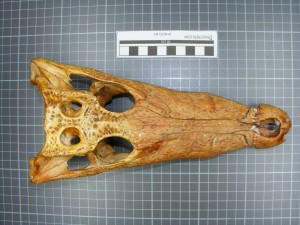Following on from the adventures in the Natural History Museum in London, checking out some of their extant crocs and the material of Theriosuchus pusillus, a dwarf croc from the Upper Jurassic of England, I made a trip to the Royal Veterinary College just north of London to see what they had on offer. John Hutchinson was kind enough to sort things out at short notice, and I actually got to check out what’s in John’s freezer, and see the mighty Freezersaurus! Entombed in icy death, John had everything from turkeys, elephant feet, a whole manner of ‘primitive’ birds (such as ratites), bits of rhino, and a miscellaneous melange of fleshy pseudopodia. All for science. As well as this, there were some living birds, including emus, for live biomechanical testing.
Crocodiles! They’re everywhere!
The Natural History Museum in London contains some of the most diverse vertebrate Palaeontological collections in the world, in terms of number of species. As part of my PhD, I have to learn detailed crocodile anatomy, mostly skeletal (osteology), to help identify and describe the particular group I’ll be researching into. The Zoology Department would normally be a great target to go and learn this, but for reasons undisclosed, they were unavailable for research visits. Fortunately, Lorna Steel, a curator of the fossil vertebrates, informed me that they had some extant croc material I could come and play with! Seeing as Imperial College is next door to the NHM, I trotted off to have a peak.
What do people know already about geoscience?
The previous post addressed the issue of why academics should bother with science communication and outreach activities, based on a recent article by Prof. Iain Stewart and Ted Nield. This next post in the series is concerned with what the general public already know about geology/geoscience, and how this underpins what should be, or needs to be, communicated, and how.
Why bother communicating?
Every breed of scientist is coming under increasing pressure and encouragement to communicate their research and knowledge to the wider public. For each discipline, sub-discipline, and not-quite-a-discipline, there are differences in the way science needs to be, and should be communicated, depending on the appeal of the subject, and the target audience(s). A recent paper by Iain Stewart (from TV, and a professor of some sort – he even has his own Wikipedia page!) and Ted Nield (sci-comm jedi, and editor of Geoscientist magazine), set out to explore how geoscientists can effectively communicate and engage the wider public with their science. How do we get people from taxi drivers, ice-cream men, the barrister at Starbucks, you, and every other person out there interested in geoscience, assuming of course that they want to (which, as you’ll see, a surprising many don’t). Their study is pretty wizard, but unfortunately it’s stuck behind a paywall, which means fewer people will be aware of what I reckon is a pretty important study for geologists to get hold of, and equip themselves with (Note: I have spoken to Iain about this, and he’ll hopefully be making a copy available somewhere!) So I just kinda wanted to summarise the key issues and points raised, as well as the suggestions made to overcome engagement obstacles to help make geologists more effective science communicators.

